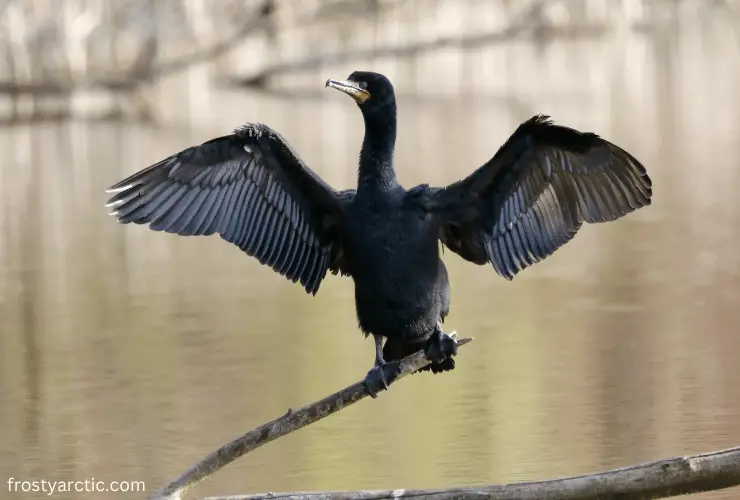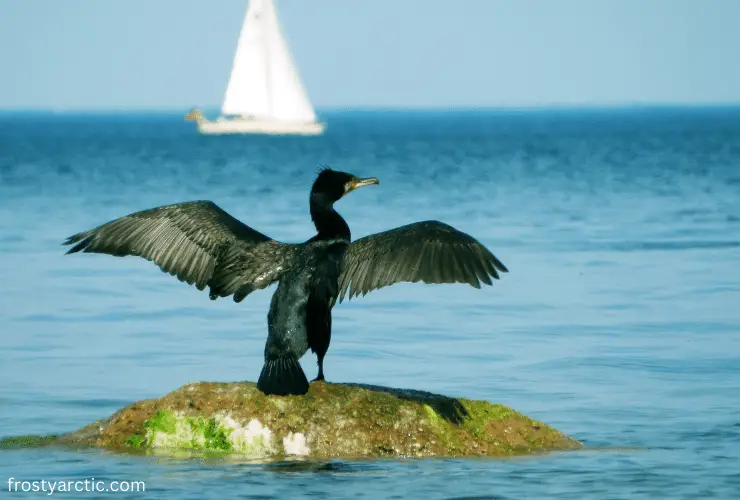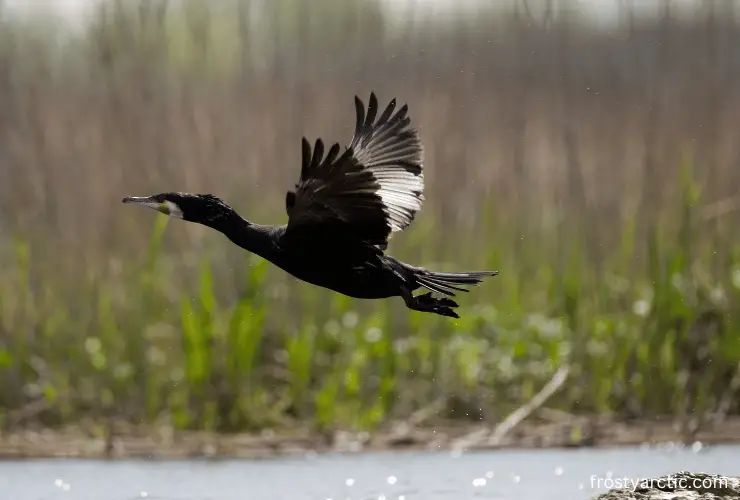The cormorant bird has some unique and exceptional characteristics, like being loyal to the colony and mate, being able to dive and hunt fish despite not having waterproof feathers, etc. Scientists and archeologists say that cormorants have been like this for quite some time.
They’ve evolved significantly and divided themselves into more than 30 species, yet these birds inherit the primary instincts.
The Cormorant is one of those bird families whose ancestors lived in the dinosaur age. The name of this ancient bird is also present in the Bible and some Greek classics. So, people are no doubt quite curious about cormorants.
The surprising thing about cormorants is that you may consider a group of cormorants as a pact of unique duck species if you haven’t seen them before. But their behavior is way different from other sea or coastal birds in Europe and North America.
What is Cormorant? Why is it Called Cormorant?
In many English dictionaries, cormorant refers to the tendency to greed or gluttony. People who have endless greed or the desire to have more are often symbolized as cormorants in many novels from the west of the world.

The cormorant is actually a coastal bird living on fish hunting near shores and cliffs. Cormorants are larger than ducks but not as big as swans. As their ancestors used to stay near freshwaters, you can see cormorants living by English, Mexican, and American water channels.
The term cormorant has come from Medieval Latin literature. You can find “Jack the Giant Killer” novel mentioning Cormorant, meaning a giant of the ocean. Ultimately, cormorant means sea raven, as most cormorants have deep black feathers, great hunting skills, and the habit of residing by seashores.
What Is Special About the Cormorant? 5 Interesting Facts
The whole lifestyle of a cormorant bird is quite special. You can find research papers with thousands of facts concluding cormorants as a very special bird family that has existed for a very long time.
However, here are the key things about cormorants that make you want to know more about them.
1. Cormorants are Completely Socialized
It’s said earlier that cormorants are colonial birds. Each cormorant colony consists of 3000 members at least.
A colony of cormorants has a strong bonding between all the members. You can find a cormorant nest near other cormorant nests, as it’s believed that predators won’t dare to attack often when too many birds and pairs are around.
Besides, recent documentaries have also shown that cormorants share their hunting trips with other bird families if needed.
Usually, you won’t see cormorants fighting with each other to compete for food. Instead, they tag along and hunt fish together for the betterment.
2. They’re Good at Hunting
In many places, cormorants are considered a key competitor class for the fishermen in the sea. They are pretty quick both over and inside water. The webbed feet and hooked bill help these birds to reach and grab fish firmly.
An adult cormorant consumes around 0.5 kilograms of fish normally in a day. Cormorants have good eyes that can track down underwater fish.
They fly over the water and chase down prey until the right moment to dive and get a firm grab. Bills bent on top don’t allow any prey to slip and run.
Sometimes, these birds can instantly kill prey by clipping with those bills.
3. Diving is Cormorants’ Best Skill
Cormorants are fantastic divers too. Unlike other diving waterbirds, cormorants don’t have waterproof waxing on feathers. That’s why they easily get wet and spend most of their day drying under the sun after fishing.
But this doesn’t change anything. Instead, it works like an advantage for cormorants.
When the feathers get wet, the body weight increases and helps a cormorant to dive deeper into the water to reach out for food.

Another fun fact is some cormorants gulp one or two small stones from shores before diving. It’s another way to gain added weight and dive deeper. Later after hunting, these sea crows return the pebbles from their stomach.
4. A Cormorant Prioritizes Nesting
Nesting is a vital part of a cormorant’s life. Building a nest with a partner makes a cormorant adult. From picking up the nesting spot to collecting materials, cormorant couples divide the works and build a nest as soon as possible to mate.
Usually, young cormorants choose to stay near the ground. But adult cormorants nest on higher surfaces or sometimes a bit far from the hunting spots.
The best part is cormorants can adapt to the situation quite well. That’s why they can nest in human ruins and hard rocky cliffs.
Although the nesting area is personal for a cormorant couple, you’d see several nests near each other. Staying close helps them to communicate with each other and migrate together when in danger.
And the most special thing about cormorants’ nesting is they reuse the same nest every mating season unless one bird of the couple dies or leaves the relationship.
5. Cormorants Believe in Courtship Relation
Courtship relationship is like human marriage. A cormorant couple follows a courtship relationship and shares the duties and responsibilities with each other.
For example, the male bird collects the materials for making a nest, while the female bird makes the nest accordingly.
A cormorant can never choose more than one partner at a time. Thus, the cormorant can be assumed as a loyal bird. It doesn’t change the partner unless the previous one is dead, lost, or unable to breed.
Are Cormorants Intelligent?
Obviously, the cormorant bird family is intelligent enough to survive till now. Every cormorant knows how to protect itself and stay away from dangers.
The main reason why you should also call them intelligent as they adapt to the situation pretty well. You’d rarely see a group of cormorants migrating. It’s because the environment isn’t a big headache for this bird type. Any dry place where they won’t catch the attention of predators is good for them to nest. They aren’t too picky at all.
Apart from all that, a cormorant never becomes a competitor for another fellow cormorant of the same colony. That’s why they don’t suffer from food scarcity.
Aged cormorants become quite sensible by growing older. Those birds leave the most comfortable area of the colony for young members to live well and settle their own personal spaces in the higher grounds where they aren’t often seen by other creatures.
A cormorant sometimes changes colonies to reduce pressure from the previous group. When a cormorant sees its exitance might increase the competition for food or partner to mate, it instantly decides to change the location along with other birds who feel the same.
So, all these things sum up one thing: cormorants can think well and make smart moves. They don’t make wrong decisions so easily.
Are Cormorants A Problem?
The answer is both yes and no. We know how important biodiversity is. Without it, the system of this planet might face some difficulties. That’s why the existence of birds like cormorants is important to have a balance in the livestock.
But the other side of the coin says something else. As you can see, cormorants mainly live on fish. When a large group or colony of cormorants start to live near inland waters where humans catch fish, an unnamed fight starts between the birds and mankind.
When the cormorant population grows significantly in an area, the reproduction rate of fish declines at a noticeable rate. Fisheries face a huge loss when fishes find the inland waters to be unsafe for breeding and move away.
Some even say that cormorants eat only when they need. Still, a cormorant requires 500 grams of fish daily. This means a colony of only a hundred cormorants would eat up to nearly 50 kilograms of fish daily. And to be honest, the number of fish is quite huge for small fishermen to earn and live.
Indeed, the sudden population growth of cormorants can have both positive and negative impacts on nature. But the negative impacts seem to be more harmful to humans, especially commercial fisheries.
What Is the Significance of The Cormorant as A Bird?
Cormorants generally symbolize bad things. In Bible, the name of the cormorant bird is present in the Hebrew language. That term mostly means something “Unholy.” For example,
“And flocks shall lie down in the midst of her, all the beasts of the nations: both the cormorant and the bittern shall lodge in the upper lintels of it; their voice shall sing in the windows; desolation shall be in the thresholds: for he shall uncover the cedar work.?” (Zeph 2:14)

Except that the epic “Paradise Lost” has noted cormorant as a sign or synonym of greed. Some areas of Europe used to believe that seeing cormorants while on a voyage meant the journey is going to take some rough turns.
Besides, Norwegians accepted that cormorants sitting on church roofs indicated that someone had to die soon.
FAQs
How long can a cormorant stay underwater?
Cormorants can hold their breath for around 2-4 minutes to stay underwater and look for food. But older cormorants might be able to hold their breath much longer than 4 minutes due to their vast experience and adaptability with hunting techniques.
Do cormorants bite?
Yes, cormorants can bite if they feel you are dangerous to them. Although cormorants don’t stay near humans even after showing friendliness, they would rather try to fly than bite after seeing anything unusual around. They would bite when there’s no way to survive left.
What are cormorants good for?
Cormorants are good for the firm diving in any water mainly. These coastal birds can also fly at a decent speed if needed. So, the survivability of cormorants is a pretty noticeable matter.
What are cormorants scared of?
Cormorants are basically scared of their predators. Eagles, gulls, raccoons, foxes, etc., often hunt down adult or baby cormorants. Besides them, cormorants easily get scared away by any object unusual to them.
Summary
It’s hard to specify only one fact special about the Phalacrocoracidae or cormorant family. However, in my opinion, the hunting skills that cormorants obtained from their ancestors long ago are the most special fact about them.
It is because their natural instincts and body structure allow them to precisely catch fish more than any other seabirds despite not being of a ferocious average family.
The first thing that helps cormorants in hunting is the feathers that waterlogged to gain weight. Then, it’s their webbed feet allow them to dive deeper. Last but not least, their bills mainly help them to catch or kill prey in close ranges.
Together, all these features make cormorants one of the finest opportunist hunter-class birds in nature.


